LCBB5003 - Management Economics: Analyzing Tesco's Market Position
VerifiedAdded on 2023/06/18
|11
|3574
|204
Report
AI Summary
This report provides a comprehensive analysis of Tesco, a UK-based international retailer, from a management economics perspective. It explores the company's origins, its range of goods and services, and its evolution within the industry. The report assesses Tesco's market structure, identifying it as an oligopoly, and examines the strategies the company employs for targeting, segmentation, and positioning. It delves into the characteristics of the firm's sector of operation, including competitive dynamics and regulatory frameworks. Furthermore, the analysis incorporates the 7 Ps of marketing and evaluates Tesco's competitive advantages and challenges within the retail landscape. The report uses market share data and financial information to support its findings, providing a holistic view of Tesco's economic environment and strategic approach.
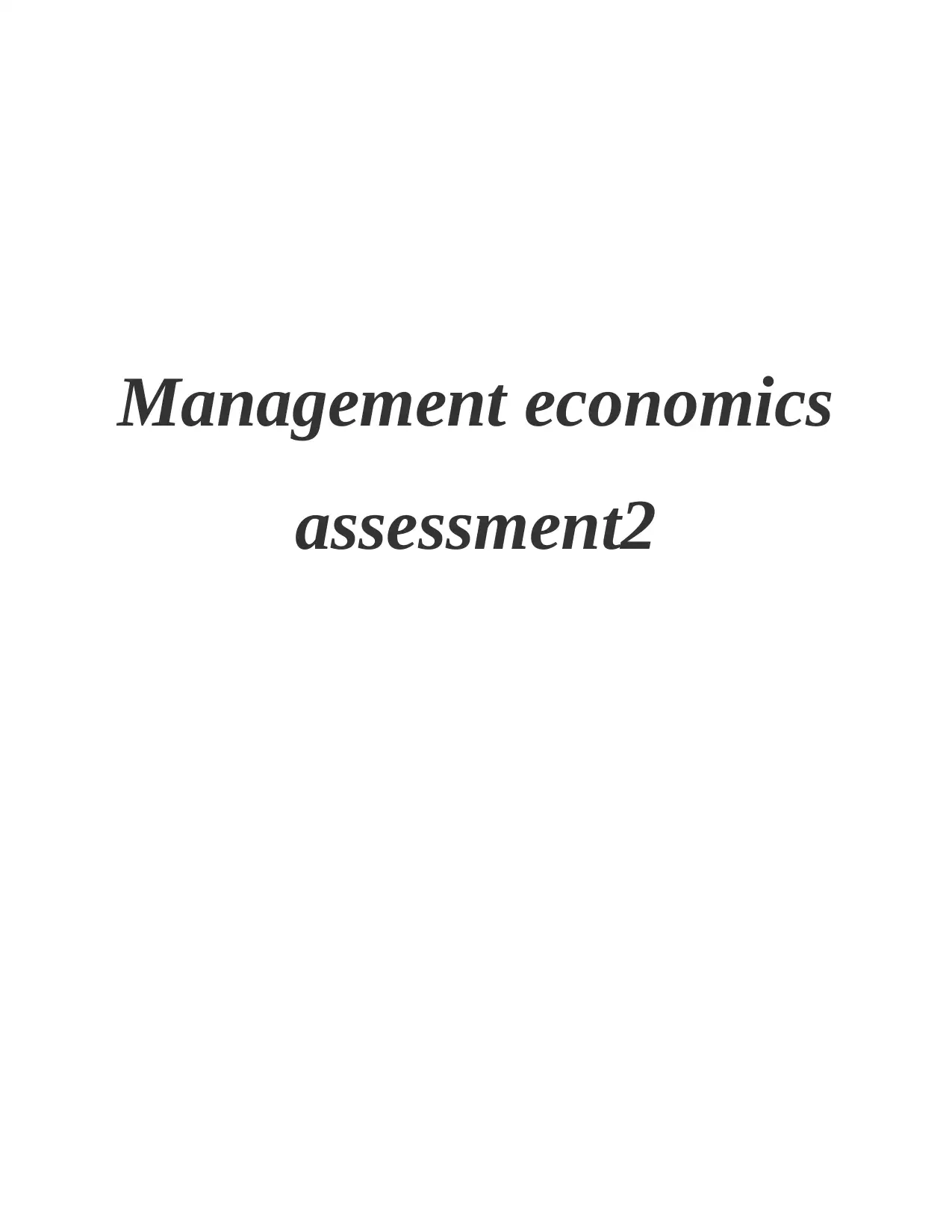
Management economics
assessment2
assessment2
Paraphrase This Document
Need a fresh take? Get an instant paraphrase of this document with our AI Paraphraser
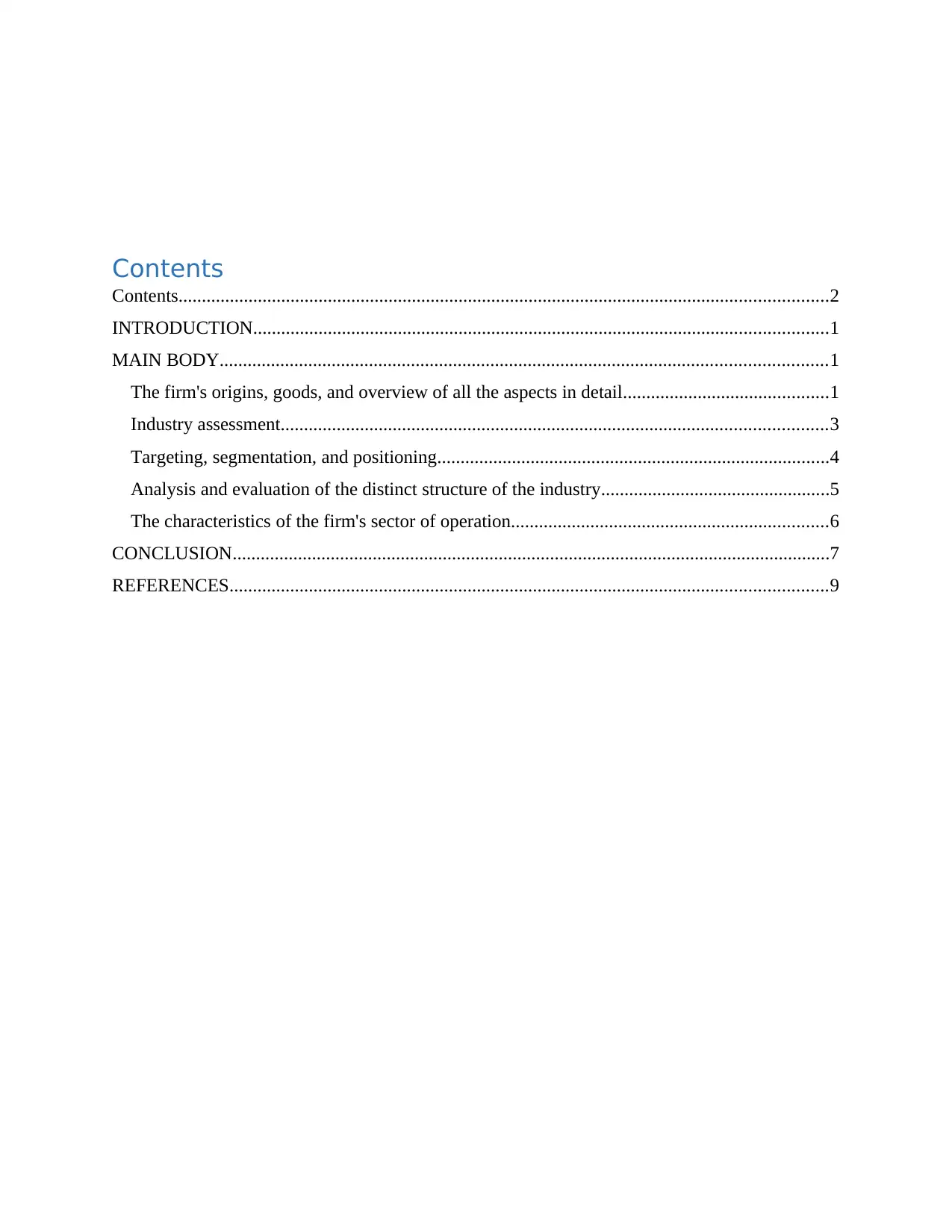
Contents
Contents...........................................................................................................................................2
INTRODUCTION...........................................................................................................................1
MAIN BODY..................................................................................................................................1
The firm's origins, goods, and overview of all the aspects in detail............................................1
Industry assessment.....................................................................................................................3
Targeting, segmentation, and positioning....................................................................................4
Analysis and evaluation of the distinct structure of the industry.................................................5
The characteristics of the firm's sector of operation....................................................................6
CONCLUSION................................................................................................................................7
REFERENCES................................................................................................................................9
Contents...........................................................................................................................................2
INTRODUCTION...........................................................................................................................1
MAIN BODY..................................................................................................................................1
The firm's origins, goods, and overview of all the aspects in detail............................................1
Industry assessment.....................................................................................................................3
Targeting, segmentation, and positioning....................................................................................4
Analysis and evaluation of the distinct structure of the industry.................................................5
The characteristics of the firm's sector of operation....................................................................6
CONCLUSION................................................................................................................................7
REFERENCES................................................................................................................................9
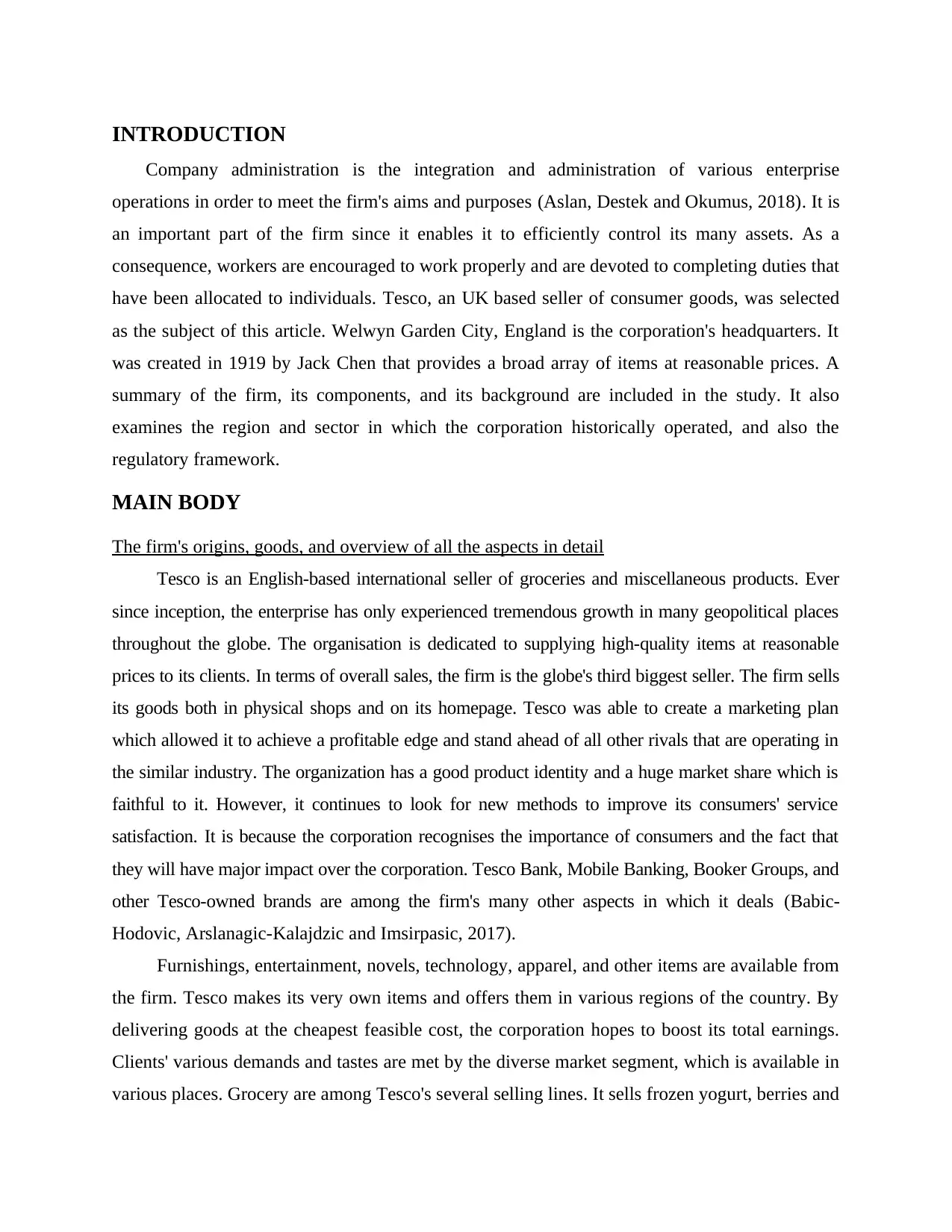
INTRODUCTION
Company administration is the integration and administration of various enterprise
operations in order to meet the firm's aims and purposes (Aslan, Destek and Okumus, 2018). It is
an important part of the firm since it enables it to efficiently control its many assets. As a
consequence, workers are encouraged to work properly and are devoted to completing duties that
have been allocated to individuals. Tesco, an UK based seller of consumer goods, was selected
as the subject of this article. Welwyn Garden City, England is the corporation's headquarters. It
was created in 1919 by Jack Chen that provides a broad array of items at reasonable prices. A
summary of the firm, its components, and its background are included in the study. It also
examines the region and sector in which the corporation historically operated, and also the
regulatory framework.
MAIN BODY
The firm's origins, goods, and overview of all the aspects in detail
Tesco is an English-based international seller of groceries and miscellaneous products. Ever
since inception, the enterprise has only experienced tremendous growth in many geopolitical places
throughout the globe. The organisation is dedicated to supplying high-quality items at reasonable
prices to its clients. In terms of overall sales, the firm is the globe's third biggest seller. The firm sells
its goods both in physical shops and on its homepage. Tesco was able to create a marketing plan
which allowed it to achieve a profitable edge and stand ahead of all other rivals that are operating in
the similar industry. The organization has a good product identity and a huge market share which is
faithful to it. However, it continues to look for new methods to improve its consumers' service
satisfaction. It is because the corporation recognises the importance of consumers and the fact that
they will have major impact over the corporation. Tesco Bank, Mobile Banking, Booker Groups, and
other Tesco-owned brands are among the firm's many other aspects in which it deals (Babic-
Hodovic, Arslanagic-Kalajdzic and Imsirpasic, 2017).
Furnishings, entertainment, novels, technology, apparel, and other items are available from
the firm. Tesco makes its very own items and offers them in various regions of the country. By
delivering goods at the cheapest feasible cost, the corporation hopes to boost its total earnings.
Clients' various demands and tastes are met by the diverse market segment, which is available in
various places. Grocery are among Tesco's several selling lines. It sells frozen yogurt, berries and
Company administration is the integration and administration of various enterprise
operations in order to meet the firm's aims and purposes (Aslan, Destek and Okumus, 2018). It is
an important part of the firm since it enables it to efficiently control its many assets. As a
consequence, workers are encouraged to work properly and are devoted to completing duties that
have been allocated to individuals. Tesco, an UK based seller of consumer goods, was selected
as the subject of this article. Welwyn Garden City, England is the corporation's headquarters. It
was created in 1919 by Jack Chen that provides a broad array of items at reasonable prices. A
summary of the firm, its components, and its background are included in the study. It also
examines the region and sector in which the corporation historically operated, and also the
regulatory framework.
MAIN BODY
The firm's origins, goods, and overview of all the aspects in detail
Tesco is an English-based international seller of groceries and miscellaneous products. Ever
since inception, the enterprise has only experienced tremendous growth in many geopolitical places
throughout the globe. The organisation is dedicated to supplying high-quality items at reasonable
prices to its clients. In terms of overall sales, the firm is the globe's third biggest seller. The firm sells
its goods both in physical shops and on its homepage. Tesco was able to create a marketing plan
which allowed it to achieve a profitable edge and stand ahead of all other rivals that are operating in
the similar industry. The organization has a good product identity and a huge market share which is
faithful to it. However, it continues to look for new methods to improve its consumers' service
satisfaction. It is because the corporation recognises the importance of consumers and the fact that
they will have major impact over the corporation. Tesco Bank, Mobile Banking, Booker Groups, and
other Tesco-owned brands are among the firm's many other aspects in which it deals (Babic-
Hodovic, Arslanagic-Kalajdzic and Imsirpasic, 2017).
Furnishings, entertainment, novels, technology, apparel, and other items are available from
the firm. Tesco makes its very own items and offers them in various regions of the country. By
delivering goods at the cheapest feasible cost, the corporation hopes to boost its total earnings.
Clients' various demands and tastes are met by the diverse market segment, which is available in
various places. Grocery are among Tesco's several selling lines. It sells frozen yogurt, berries and
⊘ This is a preview!⊘
Do you want full access?
Subscribe today to unlock all pages.

Trusted by 1+ million students worldwide
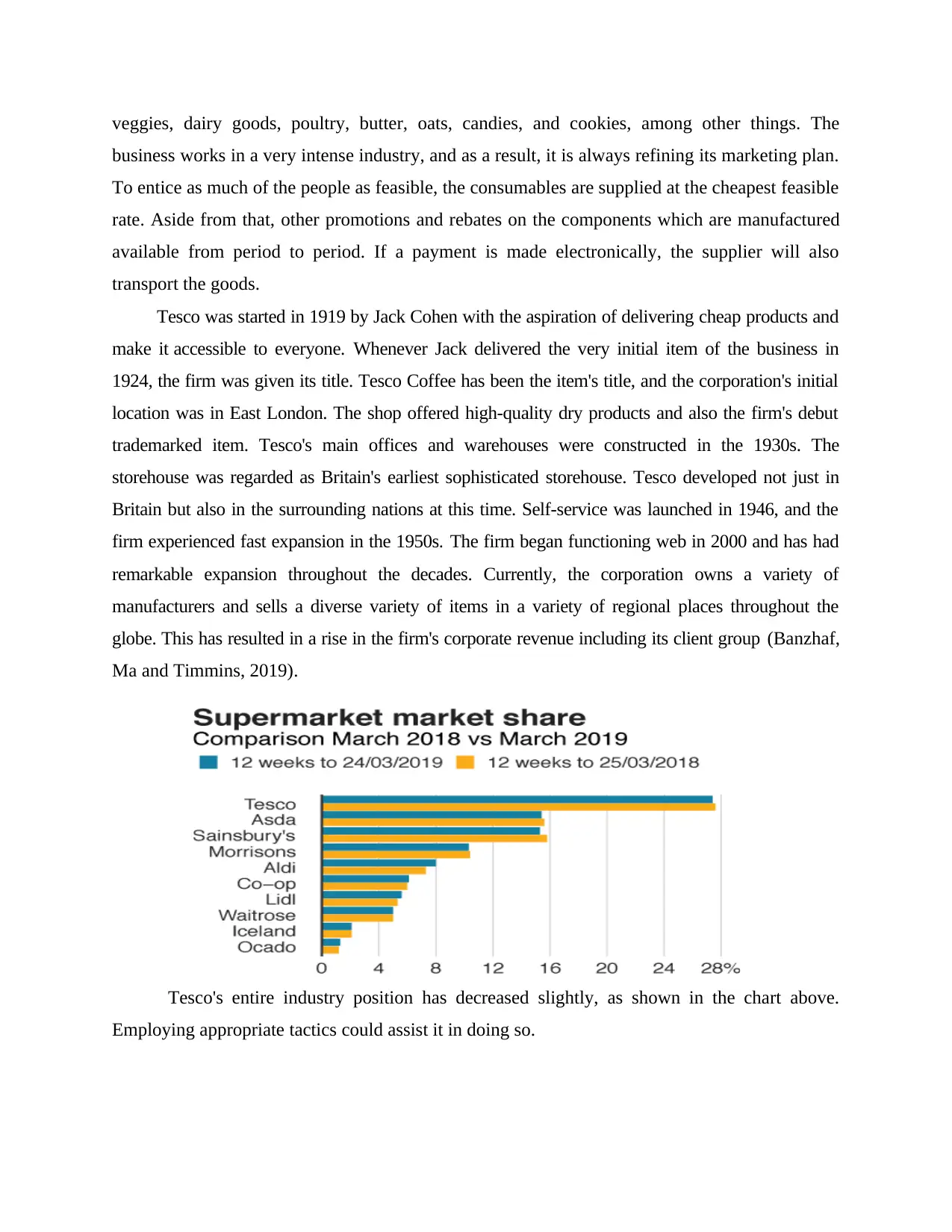
veggies, dairy goods, poultry, butter, oats, candies, and cookies, among other things. The
business works in a very intense industry, and as a result, it is always refining its marketing plan.
To entice as much of the people as feasible, the consumables are supplied at the cheapest feasible
rate. Aside from that, other promotions and rebates on the components which are manufactured
available from period to period. If a payment is made electronically, the supplier will also
transport the goods.
Tesco was started in 1919 by Jack Cohen with the aspiration of delivering cheap products and
make it accessible to everyone. Whenever Jack delivered the very initial item of the business in
1924, the firm was given its title. Tesco Coffee has been the item's title, and the corporation's initial
location was in East London. The shop offered high-quality dry products and also the firm's debut
trademarked item. Tesco's main offices and warehouses were constructed in the 1930s. The
storehouse was regarded as Britain's earliest sophisticated storehouse. Tesco developed not just in
Britain but also in the surrounding nations at this time. Self-service was launched in 1946, and the
firm experienced fast expansion in the 1950s. The firm began functioning web in 2000 and has had
remarkable expansion throughout the decades. Currently, the corporation owns a variety of
manufacturers and sells a diverse variety of items in a variety of regional places throughout the
globe. This has resulted in a rise in the firm's corporate revenue including its client group (Banzhaf,
Ma and Timmins, 2019).
Tesco's entire industry position has decreased slightly, as shown in the chart above.
Employing appropriate tactics could assist it in doing so.
business works in a very intense industry, and as a result, it is always refining its marketing plan.
To entice as much of the people as feasible, the consumables are supplied at the cheapest feasible
rate. Aside from that, other promotions and rebates on the components which are manufactured
available from period to period. If a payment is made electronically, the supplier will also
transport the goods.
Tesco was started in 1919 by Jack Cohen with the aspiration of delivering cheap products and
make it accessible to everyone. Whenever Jack delivered the very initial item of the business in
1924, the firm was given its title. Tesco Coffee has been the item's title, and the corporation's initial
location was in East London. The shop offered high-quality dry products and also the firm's debut
trademarked item. Tesco's main offices and warehouses were constructed in the 1930s. The
storehouse was regarded as Britain's earliest sophisticated storehouse. Tesco developed not just in
Britain but also in the surrounding nations at this time. Self-service was launched in 1946, and the
firm experienced fast expansion in the 1950s. The firm began functioning web in 2000 and has had
remarkable expansion throughout the decades. Currently, the corporation owns a variety of
manufacturers and sells a diverse variety of items in a variety of regional places throughout the
globe. This has resulted in a rise in the firm's corporate revenue including its client group (Banzhaf,
Ma and Timmins, 2019).
Tesco's entire industry position has decreased slightly, as shown in the chart above.
Employing appropriate tactics could assist it in doing so.
Paraphrase This Document
Need a fresh take? Get an instant paraphrase of this document with our AI Paraphraser
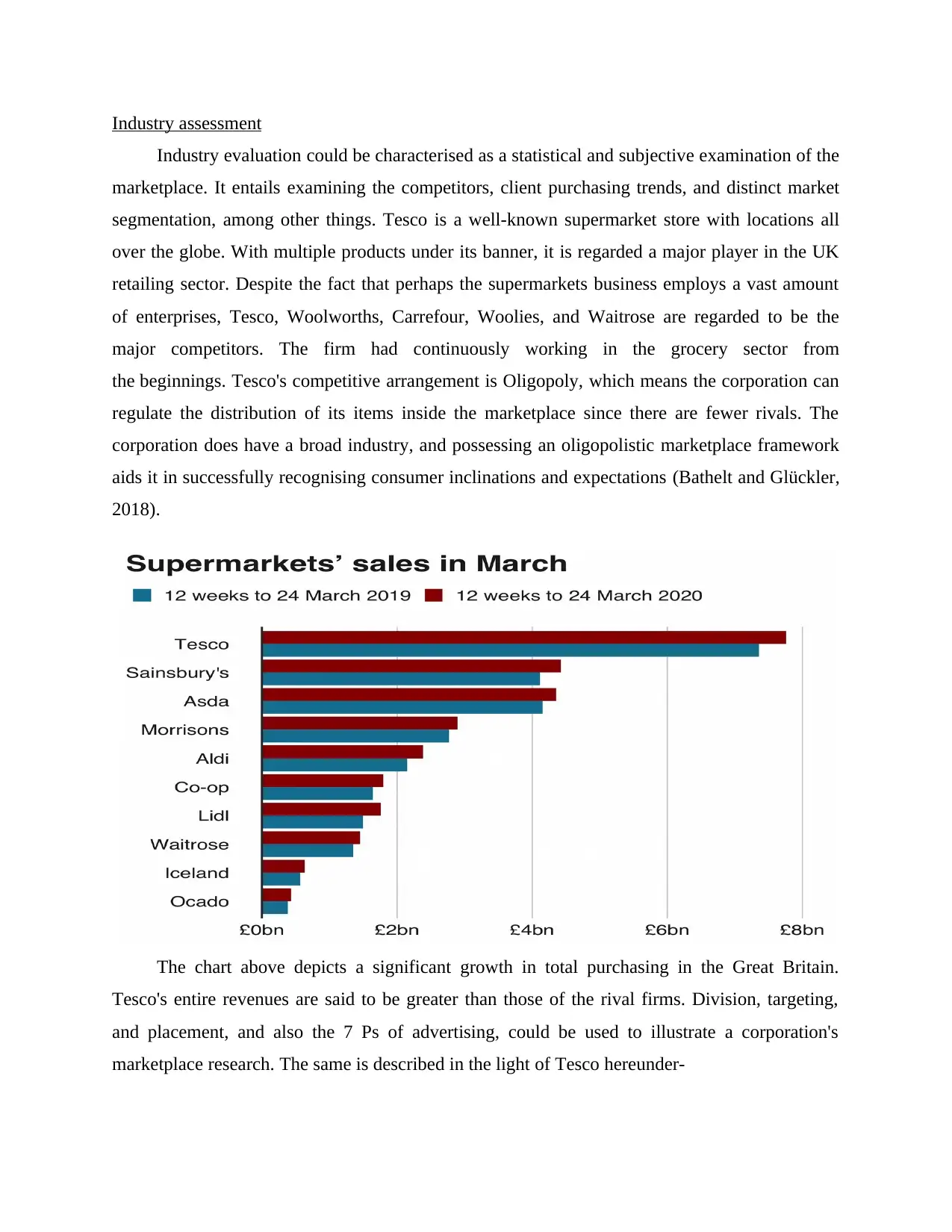
Industry assessment
Industry evaluation could be characterised as a statistical and subjective examination of the
marketplace. It entails examining the competitors, client purchasing trends, and distinct market
segmentation, among other things. Tesco is a well-known supermarket store with locations all
over the globe. With multiple products under its banner, it is regarded a major player in the UK
retailing sector. Despite the fact that perhaps the supermarkets business employs a vast amount
of enterprises, Tesco, Woolworths, Carrefour, Woolies, and Waitrose are regarded to be the
major competitors. The firm had continuously working in the grocery sector from
the beginnings. Tesco's competitive arrangement is Oligopoly, which means the corporation can
regulate the distribution of its items inside the marketplace since there are fewer rivals. The
corporation does have a broad industry, and possessing an oligopolistic marketplace framework
aids it in successfully recognising consumer inclinations and expectations (Bathelt and Glückler,
2018).
The chart above depicts a significant growth in total purchasing in the Great Britain.
Tesco's entire revenues are said to be greater than those of the rival firms. Division, targeting,
and placement, and also the 7 Ps of advertising, could be used to illustrate a corporation's
marketplace research. The same is described in the light of Tesco hereunder-
Industry evaluation could be characterised as a statistical and subjective examination of the
marketplace. It entails examining the competitors, client purchasing trends, and distinct market
segmentation, among other things. Tesco is a well-known supermarket store with locations all
over the globe. With multiple products under its banner, it is regarded a major player in the UK
retailing sector. Despite the fact that perhaps the supermarkets business employs a vast amount
of enterprises, Tesco, Woolworths, Carrefour, Woolies, and Waitrose are regarded to be the
major competitors. The firm had continuously working in the grocery sector from
the beginnings. Tesco's competitive arrangement is Oligopoly, which means the corporation can
regulate the distribution of its items inside the marketplace since there are fewer rivals. The
corporation does have a broad industry, and possessing an oligopolistic marketplace framework
aids it in successfully recognising consumer inclinations and expectations (Bathelt and Glückler,
2018).
The chart above depicts a significant growth in total purchasing in the Great Britain.
Tesco's entire revenues are said to be greater than those of the rival firms. Division, targeting,
and placement, and also the 7 Ps of advertising, could be used to illustrate a corporation's
marketplace research. The same is described in the light of Tesco hereunder-
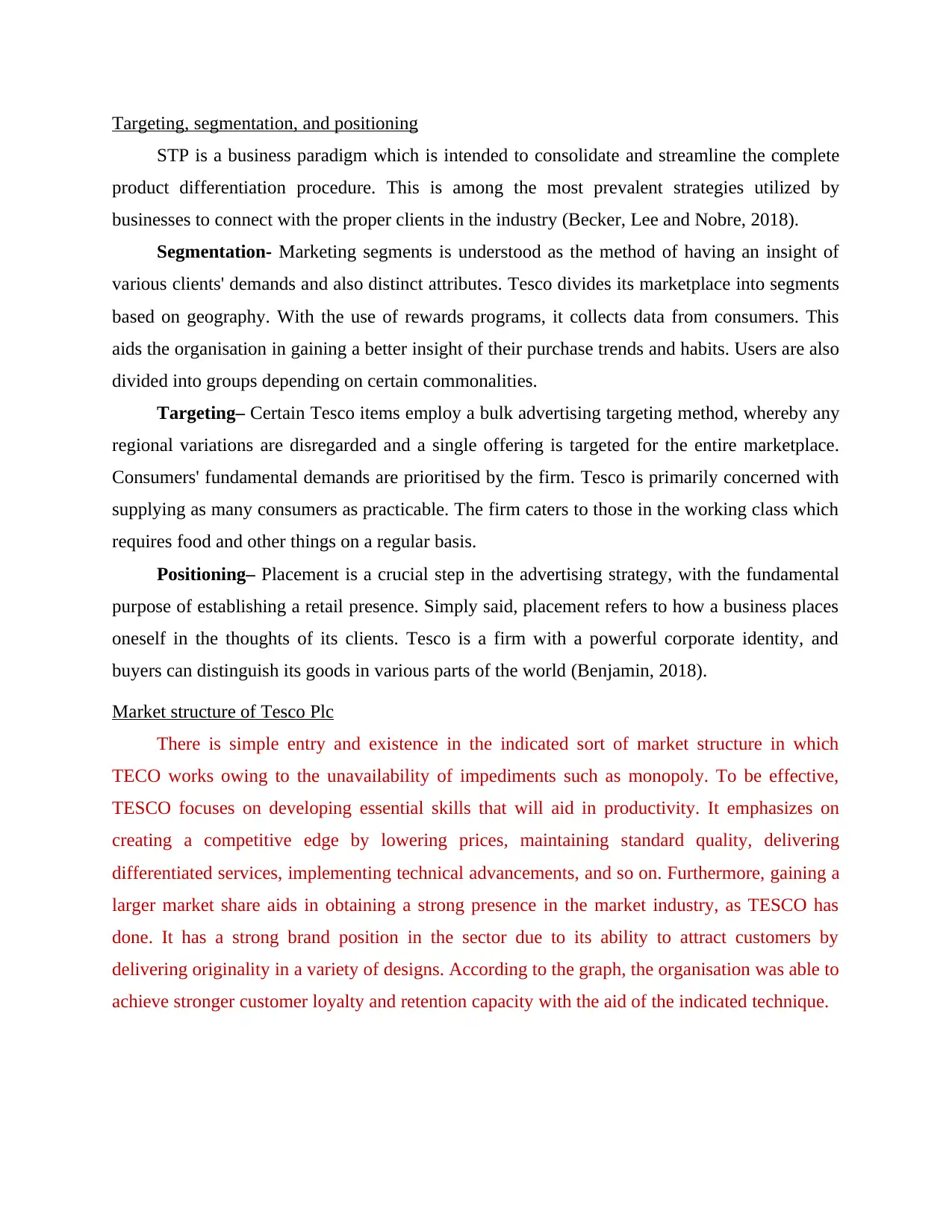
Targeting, segmentation, and positioning
STP is a business paradigm which is intended to consolidate and streamline the complete
product differentiation procedure. This is among the most prevalent strategies utilized by
businesses to connect with the proper clients in the industry (Becker, Lee and Nobre, 2018).
Segmentation- Marketing segments is understood as the method of having an insight of
various clients' demands and also distinct attributes. Tesco divides its marketplace into segments
based on geography. With the use of rewards programs, it collects data from consumers. This
aids the organisation in gaining a better insight of their purchase trends and habits. Users are also
divided into groups depending on certain commonalities.
Targeting– Certain Tesco items employ a bulk advertising targeting method, whereby any
regional variations are disregarded and a single offering is targeted for the entire marketplace.
Consumers' fundamental demands are prioritised by the firm. Tesco is primarily concerned with
supplying as many consumers as practicable. The firm caters to those in the working class which
requires food and other things on a regular basis.
Positioning– Placement is a crucial step in the advertising strategy, with the fundamental
purpose of establishing a retail presence. Simply said, placement refers to how a business places
oneself in the thoughts of its clients. Tesco is a firm with a powerful corporate identity, and
buyers can distinguish its goods in various parts of the world (Benjamin, 2018).
Market structure of Tesco Plc
There is simple entry and existence in the indicated sort of market structure in which
TECO works owing to the unavailability of impediments such as monopoly. To be effective,
TESCO focuses on developing essential skills that will aid in productivity. It emphasizes on
creating a competitive edge by lowering prices, maintaining standard quality, delivering
differentiated services, implementing technical advancements, and so on. Furthermore, gaining a
larger market share aids in obtaining a strong presence in the market industry, as TESCO has
done. It has a strong brand position in the sector due to its ability to attract customers by
delivering originality in a variety of designs. According to the graph, the organisation was able to
achieve stronger customer loyalty and retention capacity with the aid of the indicated technique.
STP is a business paradigm which is intended to consolidate and streamline the complete
product differentiation procedure. This is among the most prevalent strategies utilized by
businesses to connect with the proper clients in the industry (Becker, Lee and Nobre, 2018).
Segmentation- Marketing segments is understood as the method of having an insight of
various clients' demands and also distinct attributes. Tesco divides its marketplace into segments
based on geography. With the use of rewards programs, it collects data from consumers. This
aids the organisation in gaining a better insight of their purchase trends and habits. Users are also
divided into groups depending on certain commonalities.
Targeting– Certain Tesco items employ a bulk advertising targeting method, whereby any
regional variations are disregarded and a single offering is targeted for the entire marketplace.
Consumers' fundamental demands are prioritised by the firm. Tesco is primarily concerned with
supplying as many consumers as practicable. The firm caters to those in the working class which
requires food and other things on a regular basis.
Positioning– Placement is a crucial step in the advertising strategy, with the fundamental
purpose of establishing a retail presence. Simply said, placement refers to how a business places
oneself in the thoughts of its clients. Tesco is a firm with a powerful corporate identity, and
buyers can distinguish its goods in various parts of the world (Benjamin, 2018).
Market structure of Tesco Plc
There is simple entry and existence in the indicated sort of market structure in which
TECO works owing to the unavailability of impediments such as monopoly. To be effective,
TESCO focuses on developing essential skills that will aid in productivity. It emphasizes on
creating a competitive edge by lowering prices, maintaining standard quality, delivering
differentiated services, implementing technical advancements, and so on. Furthermore, gaining a
larger market share aids in obtaining a strong presence in the market industry, as TESCO has
done. It has a strong brand position in the sector due to its ability to attract customers by
delivering originality in a variety of designs. According to the graph, the organisation was able to
achieve stronger customer loyalty and retention capacity with the aid of the indicated technique.
⊘ This is a preview!⊘
Do you want full access?
Subscribe today to unlock all pages.

Trusted by 1+ million students worldwide
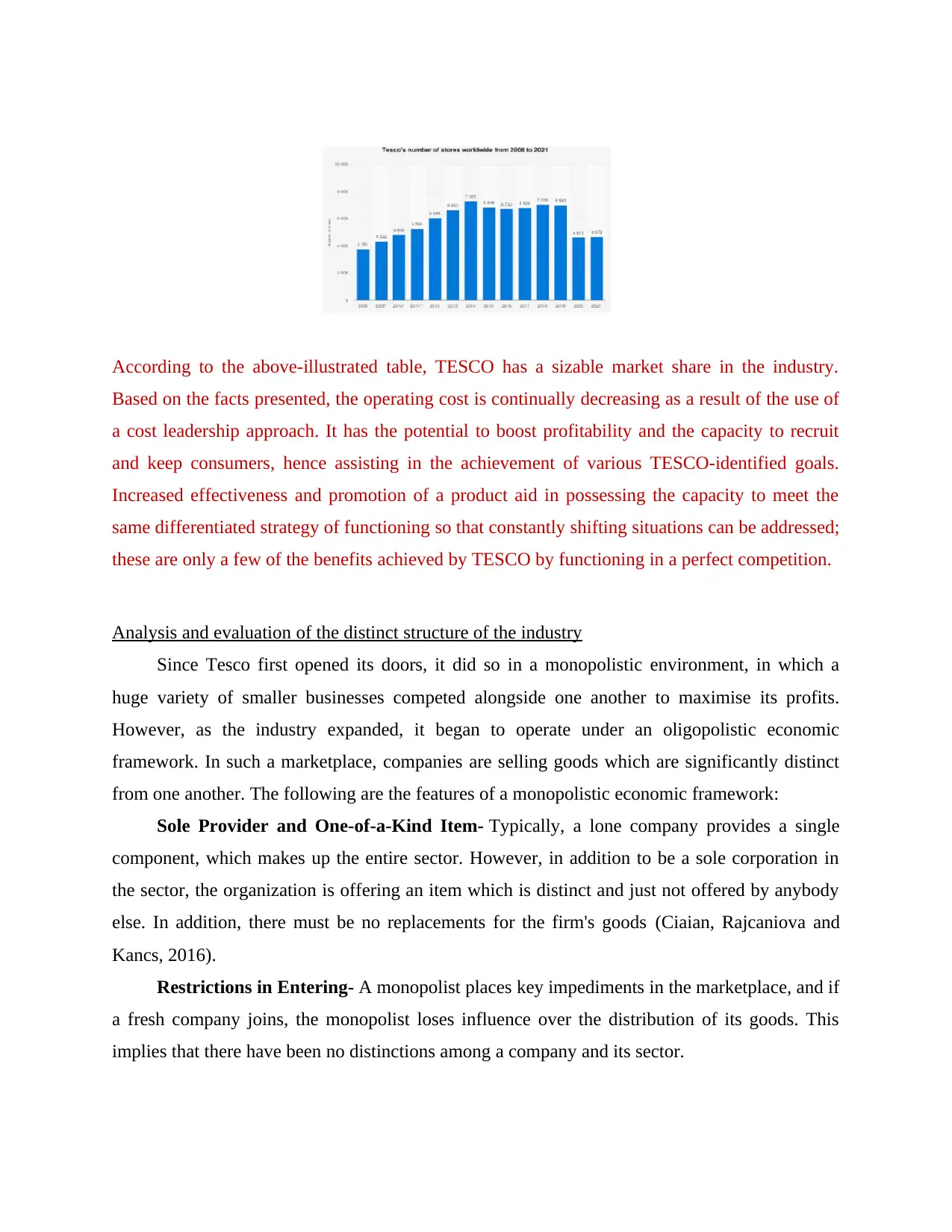
According to the above-illustrated table, TESCO has a sizable market share in the industry.
Based on the facts presented, the operating cost is continually decreasing as a result of the use of
a cost leadership approach. It has the potential to boost profitability and the capacity to recruit
and keep consumers, hence assisting in the achievement of various TESCO-identified goals.
Increased effectiveness and promotion of a product aid in possessing the capacity to meet the
same differentiated strategy of functioning so that constantly shifting situations can be addressed;
these are only a few of the benefits achieved by TESCO by functioning in a perfect competition.
Analysis and evaluation of the distinct structure of the industry
Since Tesco first opened its doors, it did so in a monopolistic environment, in which a
huge variety of smaller businesses competed alongside one another to maximise its profits.
However, as the industry expanded, it began to operate under an oligopolistic economic
framework. In such a marketplace, companies are selling goods which are significantly distinct
from one another. The following are the features of a monopolistic economic framework:
Sole Provider and One-of-a-Kind Item- Typically, a lone company provides a single
component, which makes up the entire sector. However, in addition to be a sole corporation in
the sector, the organization is offering an item which is distinct and just not offered by anybody
else. In addition, there must be no replacements for the firm's goods (Ciaian, Rajcaniova and
Kancs, 2016).
Restrictions in Entering- A monopolist places key impediments in the marketplace, and if
a fresh company joins, the monopolist loses influence over the distribution of its goods. This
implies that there have been no distinctions among a company and its sector.
Based on the facts presented, the operating cost is continually decreasing as a result of the use of
a cost leadership approach. It has the potential to boost profitability and the capacity to recruit
and keep consumers, hence assisting in the achievement of various TESCO-identified goals.
Increased effectiveness and promotion of a product aid in possessing the capacity to meet the
same differentiated strategy of functioning so that constantly shifting situations can be addressed;
these are only a few of the benefits achieved by TESCO by functioning in a perfect competition.
Analysis and evaluation of the distinct structure of the industry
Since Tesco first opened its doors, it did so in a monopolistic environment, in which a
huge variety of smaller businesses competed alongside one another to maximise its profits.
However, as the industry expanded, it began to operate under an oligopolistic economic
framework. In such a marketplace, companies are selling goods which are significantly distinct
from one another. The following are the features of a monopolistic economic framework:
Sole Provider and One-of-a-Kind Item- Typically, a lone company provides a single
component, which makes up the entire sector. However, in addition to be a sole corporation in
the sector, the organization is offering an item which is distinct and just not offered by anybody
else. In addition, there must be no replacements for the firm's goods (Ciaian, Rajcaniova and
Kancs, 2016).
Restrictions in Entering- A monopolist places key impediments in the marketplace, and if
a fresh company joins, the monopolist loses influence over the distribution of its goods. This
implies that there have been no distinctions among a company and its sector.
Paraphrase This Document
Need a fresh take? Get an instant paraphrase of this document with our AI Paraphraser
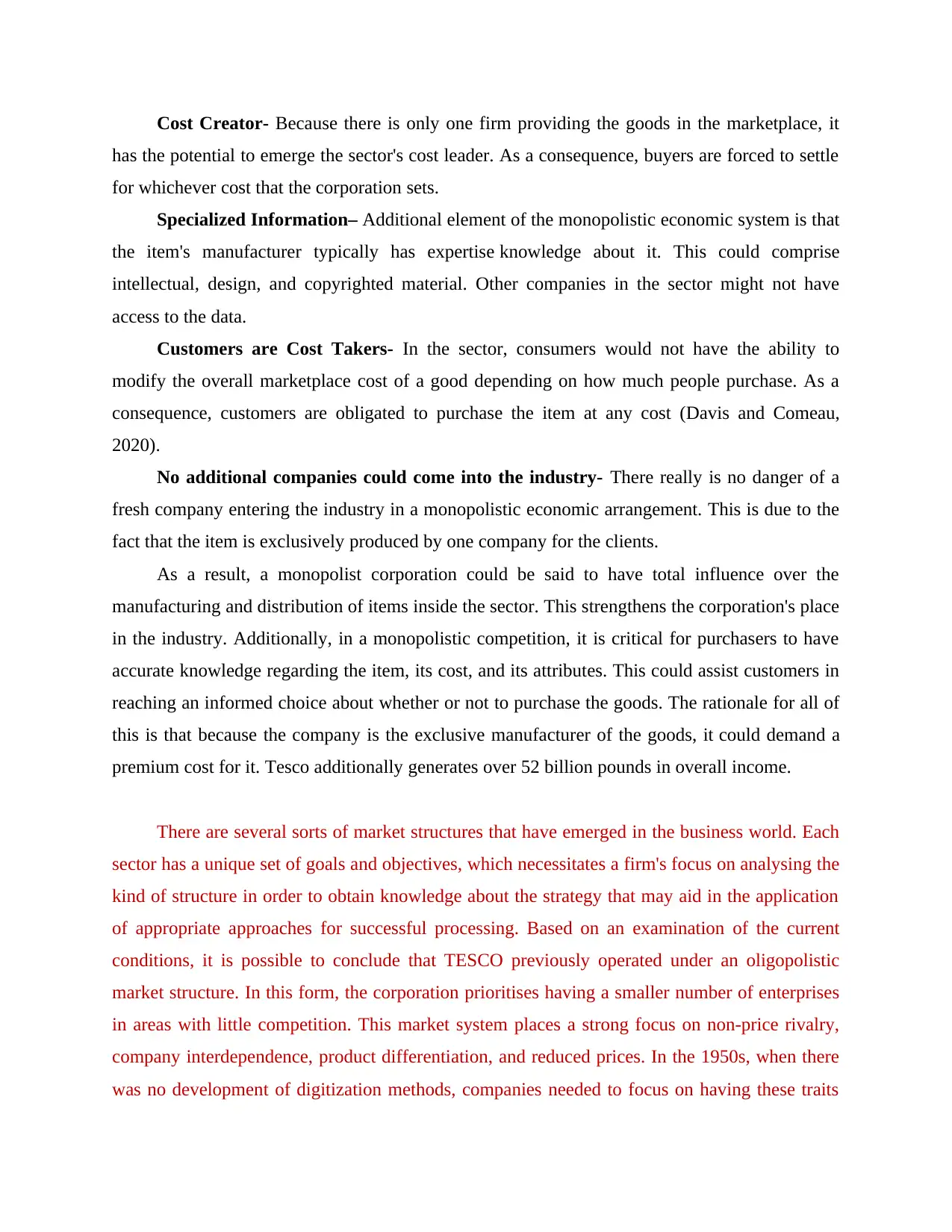
Cost Creator- Because there is only one firm providing the goods in the marketplace, it
has the potential to emerge the sector's cost leader. As a consequence, buyers are forced to settle
for whichever cost that the corporation sets.
Specialized Information– Additional element of the monopolistic economic system is that
the item's manufacturer typically has expertise knowledge about it. This could comprise
intellectual, design, and copyrighted material. Other companies in the sector might not have
access to the data.
Customers are Cost Takers- In the sector, consumers would not have the ability to
modify the overall marketplace cost of a good depending on how much people purchase. As a
consequence, customers are obligated to purchase the item at any cost (Davis and Comeau,
2020).
No additional companies could come into the industry- There really is no danger of a
fresh company entering the industry in a monopolistic economic arrangement. This is due to the
fact that the item is exclusively produced by one company for the clients.
As a result, a monopolist corporation could be said to have total influence over the
manufacturing and distribution of items inside the sector. This strengthens the corporation's place
in the industry. Additionally, in a monopolistic competition, it is critical for purchasers to have
accurate knowledge regarding the item, its cost, and its attributes. This could assist customers in
reaching an informed choice about whether or not to purchase the goods. The rationale for all of
this is that because the company is the exclusive manufacturer of the goods, it could demand a
premium cost for it. Tesco additionally generates over 52 billion pounds in overall income.
There are several sorts of market structures that have emerged in the business world. Each
sector has a unique set of goals and objectives, which necessitates a firm's focus on analysing the
kind of structure in order to obtain knowledge about the strategy that may aid in the application
of appropriate approaches for successful processing. Based on an examination of the current
conditions, it is possible to conclude that TESCO previously operated under an oligopolistic
market structure. In this form, the corporation prioritises having a smaller number of enterprises
in areas with little competition. This market system places a strong focus on non-price rivalry,
company interdependence, product differentiation, and reduced prices. In the 1950s, when there
was no development of digitization methods, companies needed to focus on having these traits
has the potential to emerge the sector's cost leader. As a consequence, buyers are forced to settle
for whichever cost that the corporation sets.
Specialized Information– Additional element of the monopolistic economic system is that
the item's manufacturer typically has expertise knowledge about it. This could comprise
intellectual, design, and copyrighted material. Other companies in the sector might not have
access to the data.
Customers are Cost Takers- In the sector, consumers would not have the ability to
modify the overall marketplace cost of a good depending on how much people purchase. As a
consequence, customers are obligated to purchase the item at any cost (Davis and Comeau,
2020).
No additional companies could come into the industry- There really is no danger of a
fresh company entering the industry in a monopolistic economic arrangement. This is due to the
fact that the item is exclusively produced by one company for the clients.
As a result, a monopolist corporation could be said to have total influence over the
manufacturing and distribution of items inside the sector. This strengthens the corporation's place
in the industry. Additionally, in a monopolistic competition, it is critical for purchasers to have
accurate knowledge regarding the item, its cost, and its attributes. This could assist customers in
reaching an informed choice about whether or not to purchase the goods. The rationale for all of
this is that because the company is the exclusive manufacturer of the goods, it could demand a
premium cost for it. Tesco additionally generates over 52 billion pounds in overall income.
There are several sorts of market structures that have emerged in the business world. Each
sector has a unique set of goals and objectives, which necessitates a firm's focus on analysing the
kind of structure in order to obtain knowledge about the strategy that may aid in the application
of appropriate approaches for successful processing. Based on an examination of the current
conditions, it is possible to conclude that TESCO previously operated under an oligopolistic
market structure. In this form, the corporation prioritises having a smaller number of enterprises
in areas with little competition. This market system places a strong focus on non-price rivalry,
company interdependence, product differentiation, and reduced prices. In the 1950s, when there
was no development of digitization methods, companies needed to focus on having these traits
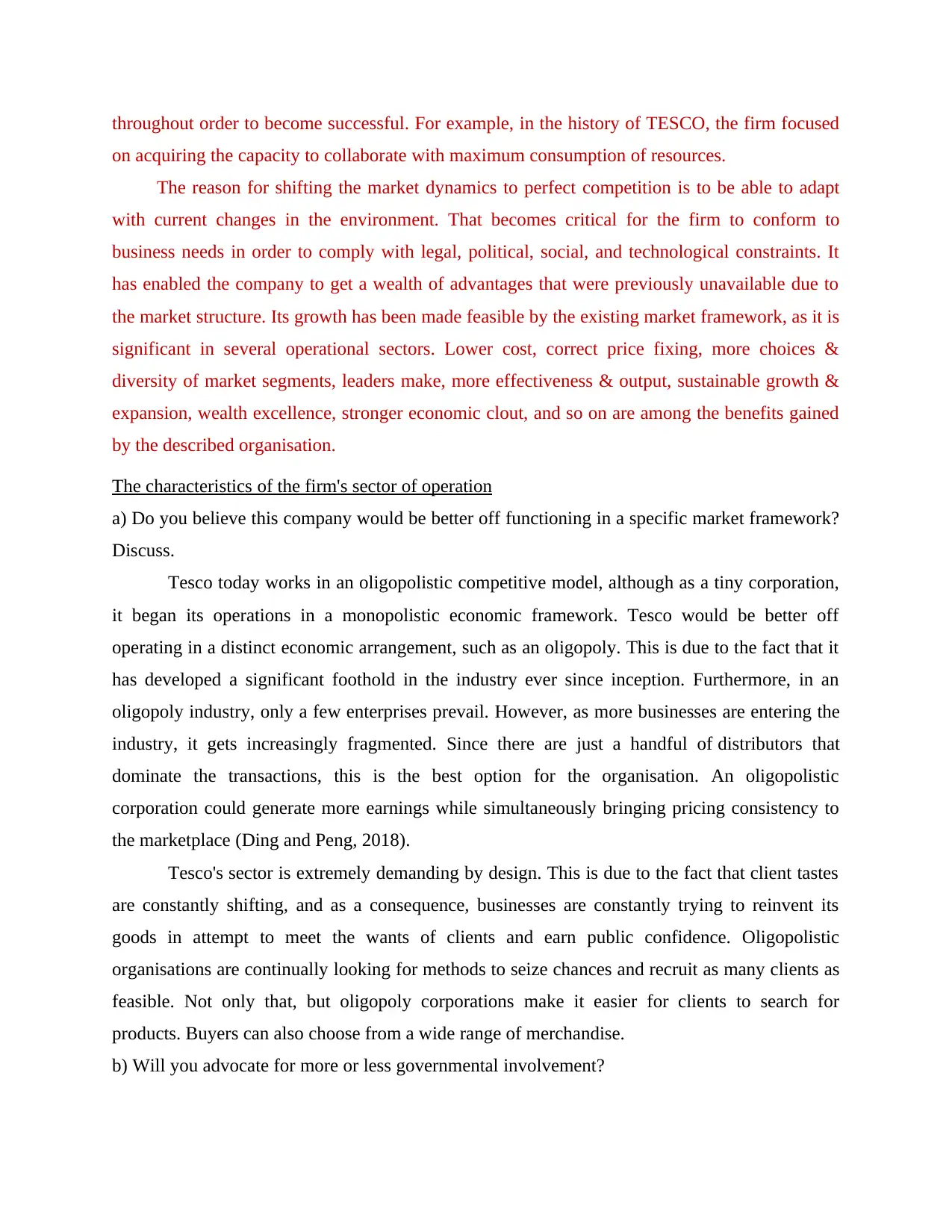
throughout order to become successful. For example, in the history of TESCO, the firm focused
on acquiring the capacity to collaborate with maximum consumption of resources.
The reason for shifting the market dynamics to perfect competition is to be able to adapt
with current changes in the environment. That becomes critical for the firm to conform to
business needs in order to comply with legal, political, social, and technological constraints. It
has enabled the company to get a wealth of advantages that were previously unavailable due to
the market structure. Its growth has been made feasible by the existing market framework, as it is
significant in several operational sectors. Lower cost, correct price fixing, more choices &
diversity of market segments, leaders make, more effectiveness & output, sustainable growth &
expansion, wealth excellence, stronger economic clout, and so on are among the benefits gained
by the described organisation.
The characteristics of the firm's sector of operation
a) Do you believe this company would be better off functioning in a specific market framework?
Discuss.
Tesco today works in an oligopolistic competitive model, although as a tiny corporation,
it began its operations in a monopolistic economic framework. Tesco would be better off
operating in a distinct economic arrangement, such as an oligopoly. This is due to the fact that it
has developed a significant foothold in the industry ever since inception. Furthermore, in an
oligopoly industry, only a few enterprises prevail. However, as more businesses are entering the
industry, it gets increasingly fragmented. Since there are just a handful of distributors that
dominate the transactions, this is the best option for the organisation. An oligopolistic
corporation could generate more earnings while simultaneously bringing pricing consistency to
the marketplace (Ding and Peng, 2018).
Tesco's sector is extremely demanding by design. This is due to the fact that client tastes
are constantly shifting, and as a consequence, businesses are constantly trying to reinvent its
goods in attempt to meet the wants of clients and earn public confidence. Oligopolistic
organisations are continually looking for methods to seize chances and recruit as many clients as
feasible. Not only that, but oligopoly corporations make it easier for clients to search for
products. Buyers can also choose from a wide range of merchandise.
b) Will you advocate for more or less governmental involvement?
on acquiring the capacity to collaborate with maximum consumption of resources.
The reason for shifting the market dynamics to perfect competition is to be able to adapt
with current changes in the environment. That becomes critical for the firm to conform to
business needs in order to comply with legal, political, social, and technological constraints. It
has enabled the company to get a wealth of advantages that were previously unavailable due to
the market structure. Its growth has been made feasible by the existing market framework, as it is
significant in several operational sectors. Lower cost, correct price fixing, more choices &
diversity of market segments, leaders make, more effectiveness & output, sustainable growth &
expansion, wealth excellence, stronger economic clout, and so on are among the benefits gained
by the described organisation.
The characteristics of the firm's sector of operation
a) Do you believe this company would be better off functioning in a specific market framework?
Discuss.
Tesco today works in an oligopolistic competitive model, although as a tiny corporation,
it began its operations in a monopolistic economic framework. Tesco would be better off
operating in a distinct economic arrangement, such as an oligopoly. This is due to the fact that it
has developed a significant foothold in the industry ever since inception. Furthermore, in an
oligopoly industry, only a few enterprises prevail. However, as more businesses are entering the
industry, it gets increasingly fragmented. Since there are just a handful of distributors that
dominate the transactions, this is the best option for the organisation. An oligopolistic
corporation could generate more earnings while simultaneously bringing pricing consistency to
the marketplace (Ding and Peng, 2018).
Tesco's sector is extremely demanding by design. This is due to the fact that client tastes
are constantly shifting, and as a consequence, businesses are constantly trying to reinvent its
goods in attempt to meet the wants of clients and earn public confidence. Oligopolistic
organisations are continually looking for methods to seize chances and recruit as many clients as
feasible. Not only that, but oligopoly corporations make it easier for clients to search for
products. Buyers can also choose from a wide range of merchandise.
b) Will you advocate for more or less governmental involvement?
⊘ This is a preview!⊘
Do you want full access?
Subscribe today to unlock all pages.

Trusted by 1+ million students worldwide
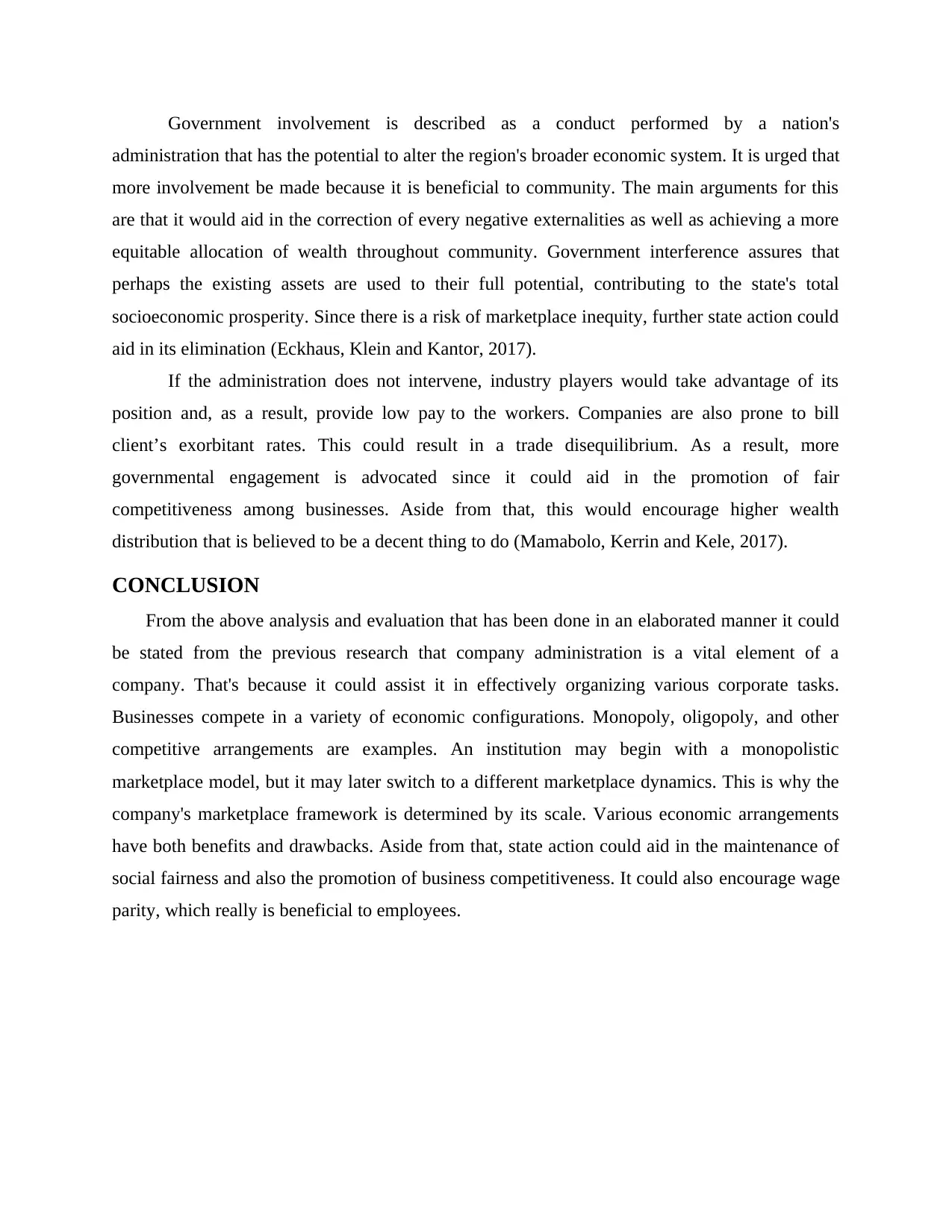
Government involvement is described as a conduct performed by a nation's
administration that has the potential to alter the region's broader economic system. It is urged that
more involvement be made because it is beneficial to community. The main arguments for this
are that it would aid in the correction of every negative externalities as well as achieving a more
equitable allocation of wealth throughout community. Government interference assures that
perhaps the existing assets are used to their full potential, contributing to the state's total
socioeconomic prosperity. Since there is a risk of marketplace inequity, further state action could
aid in its elimination (Eckhaus, Klein and Kantor, 2017).
If the administration does not intervene, industry players would take advantage of its
position and, as a result, provide low pay to the workers. Companies are also prone to bill
client’s exorbitant rates. This could result in a trade disequilibrium. As a result, more
governmental engagement is advocated since it could aid in the promotion of fair
competitiveness among businesses. Aside from that, this would encourage higher wealth
distribution that is believed to be a decent thing to do (Mamabolo, Kerrin and Kele, 2017).
CONCLUSION
From the above analysis and evaluation that has been done in an elaborated manner it could
be stated from the previous research that company administration is a vital element of a
company. That's because it could assist it in effectively organizing various corporate tasks.
Businesses compete in a variety of economic configurations. Monopoly, oligopoly, and other
competitive arrangements are examples. An institution may begin with a monopolistic
marketplace model, but it may later switch to a different marketplace dynamics. This is why the
company's marketplace framework is determined by its scale. Various economic arrangements
have both benefits and drawbacks. Aside from that, state action could aid in the maintenance of
social fairness and also the promotion of business competitiveness. It could also encourage wage
parity, which really is beneficial to employees.
administration that has the potential to alter the region's broader economic system. It is urged that
more involvement be made because it is beneficial to community. The main arguments for this
are that it would aid in the correction of every negative externalities as well as achieving a more
equitable allocation of wealth throughout community. Government interference assures that
perhaps the existing assets are used to their full potential, contributing to the state's total
socioeconomic prosperity. Since there is a risk of marketplace inequity, further state action could
aid in its elimination (Eckhaus, Klein and Kantor, 2017).
If the administration does not intervene, industry players would take advantage of its
position and, as a result, provide low pay to the workers. Companies are also prone to bill
client’s exorbitant rates. This could result in a trade disequilibrium. As a result, more
governmental engagement is advocated since it could aid in the promotion of fair
competitiveness among businesses. Aside from that, this would encourage higher wealth
distribution that is believed to be a decent thing to do (Mamabolo, Kerrin and Kele, 2017).
CONCLUSION
From the above analysis and evaluation that has been done in an elaborated manner it could
be stated from the previous research that company administration is a vital element of a
company. That's because it could assist it in effectively organizing various corporate tasks.
Businesses compete in a variety of economic configurations. Monopoly, oligopoly, and other
competitive arrangements are examples. An institution may begin with a monopolistic
marketplace model, but it may later switch to a different marketplace dynamics. This is why the
company's marketplace framework is determined by its scale. Various economic arrangements
have both benefits and drawbacks. Aside from that, state action could aid in the maintenance of
social fairness and also the promotion of business competitiveness. It could also encourage wage
parity, which really is beneficial to employees.
Paraphrase This Document
Need a fresh take? Get an instant paraphrase of this document with our AI Paraphraser
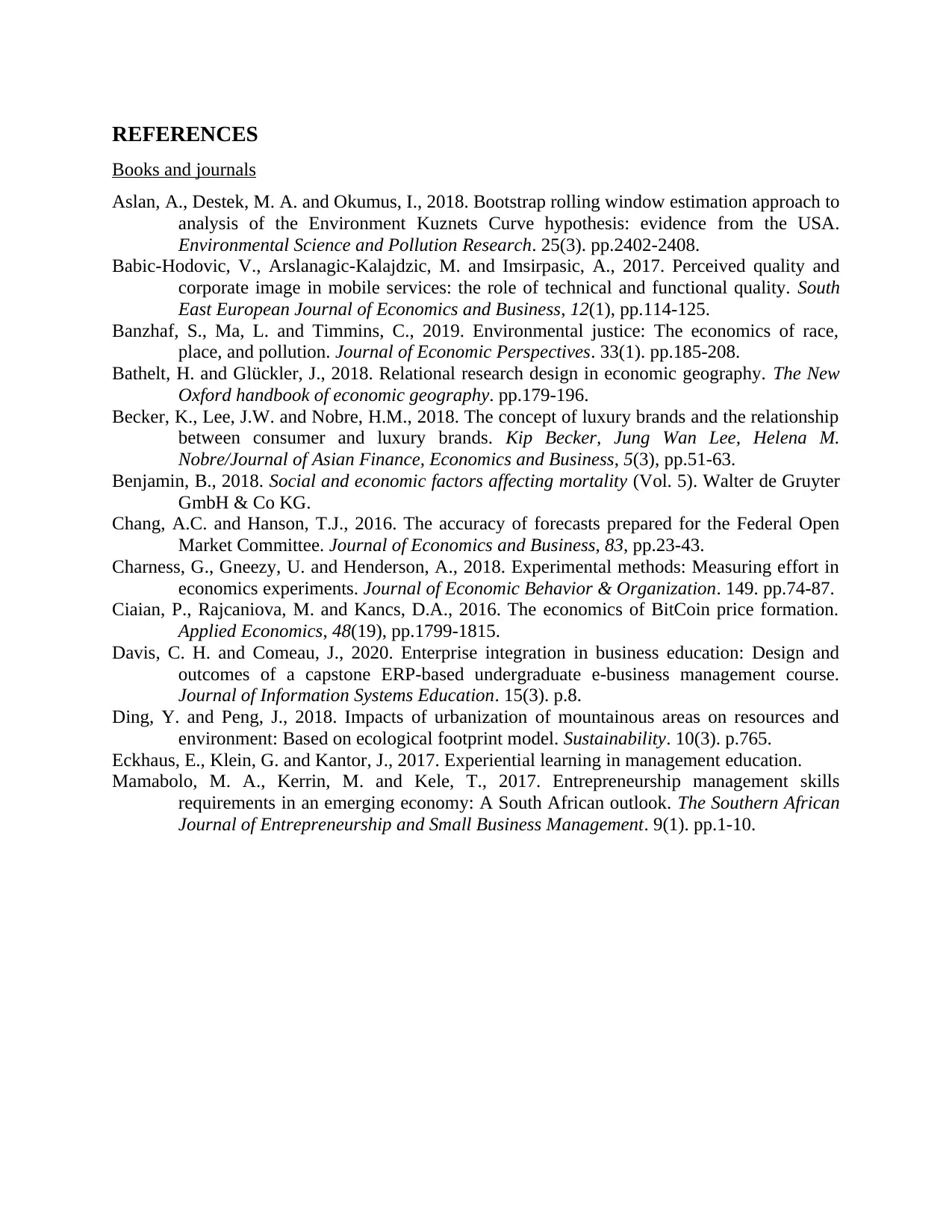
REFERENCES
Books and journals
Aslan, A., Destek, M. A. and Okumus, I., 2018. Bootstrap rolling window estimation approach to
analysis of the Environment Kuznets Curve hypothesis: evidence from the USA.
Environmental Science and Pollution Research. 25(3). pp.2402-2408.
Babic-Hodovic, V., Arslanagic-Kalajdzic, M. and Imsirpasic, A., 2017. Perceived quality and
corporate image in mobile services: the role of technical and functional quality. South
East European Journal of Economics and Business, 12(1), pp.114-125.
Banzhaf, S., Ma, L. and Timmins, C., 2019. Environmental justice: The economics of race,
place, and pollution. Journal of Economic Perspectives. 33(1). pp.185-208.
Bathelt, H. and Glückler, J., 2018. Relational research design in economic geography. The New
Oxford handbook of economic geography. pp.179-196.
Becker, K., Lee, J.W. and Nobre, H.M., 2018. The concept of luxury brands and the relationship
between consumer and luxury brands. Kip Becker, Jung Wan Lee, Helena M.
Nobre/Journal of Asian Finance, Economics and Business, 5(3), pp.51-63.
Benjamin, B., 2018. Social and economic factors affecting mortality (Vol. 5). Walter de Gruyter
GmbH & Co KG.
Chang, A.C. and Hanson, T.J., 2016. The accuracy of forecasts prepared for the Federal Open
Market Committee. Journal of Economics and Business, 83, pp.23-43.
Charness, G., Gneezy, U. and Henderson, A., 2018. Experimental methods: Measuring effort in
economics experiments. Journal of Economic Behavior & Organization. 149. pp.74-87.
Ciaian, P., Rajcaniova, M. and Kancs, D.A., 2016. The economics of BitCoin price formation.
Applied Economics, 48(19), pp.1799-1815.
Davis, C. H. and Comeau, J., 2020. Enterprise integration in business education: Design and
outcomes of a capstone ERP-based undergraduate e-business management course.
Journal of Information Systems Education. 15(3). p.8.
Ding, Y. and Peng, J., 2018. Impacts of urbanization of mountainous areas on resources and
environment: Based on ecological footprint model. Sustainability. 10(3). p.765.
Eckhaus, E., Klein, G. and Kantor, J., 2017. Experiential learning in management education.
Mamabolo, M. A., Kerrin, M. and Kele, T., 2017. Entrepreneurship management skills
requirements in an emerging economy: A South African outlook. The Southern African
Journal of Entrepreneurship and Small Business Management. 9(1). pp.1-10.
Books and journals
Aslan, A., Destek, M. A. and Okumus, I., 2018. Bootstrap rolling window estimation approach to
analysis of the Environment Kuznets Curve hypothesis: evidence from the USA.
Environmental Science and Pollution Research. 25(3). pp.2402-2408.
Babic-Hodovic, V., Arslanagic-Kalajdzic, M. and Imsirpasic, A., 2017. Perceived quality and
corporate image in mobile services: the role of technical and functional quality. South
East European Journal of Economics and Business, 12(1), pp.114-125.
Banzhaf, S., Ma, L. and Timmins, C., 2019. Environmental justice: The economics of race,
place, and pollution. Journal of Economic Perspectives. 33(1). pp.185-208.
Bathelt, H. and Glückler, J., 2018. Relational research design in economic geography. The New
Oxford handbook of economic geography. pp.179-196.
Becker, K., Lee, J.W. and Nobre, H.M., 2018. The concept of luxury brands and the relationship
between consumer and luxury brands. Kip Becker, Jung Wan Lee, Helena M.
Nobre/Journal of Asian Finance, Economics and Business, 5(3), pp.51-63.
Benjamin, B., 2018. Social and economic factors affecting mortality (Vol. 5). Walter de Gruyter
GmbH & Co KG.
Chang, A.C. and Hanson, T.J., 2016. The accuracy of forecasts prepared for the Federal Open
Market Committee. Journal of Economics and Business, 83, pp.23-43.
Charness, G., Gneezy, U. and Henderson, A., 2018. Experimental methods: Measuring effort in
economics experiments. Journal of Economic Behavior & Organization. 149. pp.74-87.
Ciaian, P., Rajcaniova, M. and Kancs, D.A., 2016. The economics of BitCoin price formation.
Applied Economics, 48(19), pp.1799-1815.
Davis, C. H. and Comeau, J., 2020. Enterprise integration in business education: Design and
outcomes of a capstone ERP-based undergraduate e-business management course.
Journal of Information Systems Education. 15(3). p.8.
Ding, Y. and Peng, J., 2018. Impacts of urbanization of mountainous areas on resources and
environment: Based on ecological footprint model. Sustainability. 10(3). p.765.
Eckhaus, E., Klein, G. and Kantor, J., 2017. Experiential learning in management education.
Mamabolo, M. A., Kerrin, M. and Kele, T., 2017. Entrepreneurship management skills
requirements in an emerging economy: A South African outlook. The Southern African
Journal of Entrepreneurship and Small Business Management. 9(1). pp.1-10.
1 out of 11
Related Documents
Your All-in-One AI-Powered Toolkit for Academic Success.
+13062052269
info@desklib.com
Available 24*7 on WhatsApp / Email
![[object Object]](/_next/static/media/star-bottom.7253800d.svg)
Unlock your academic potential
Copyright © 2020–2025 A2Z Services. All Rights Reserved. Developed and managed by ZUCOL.




